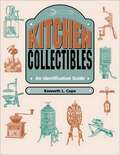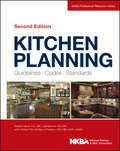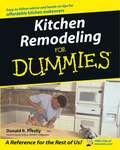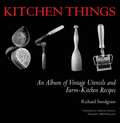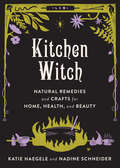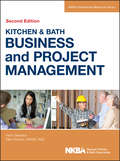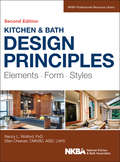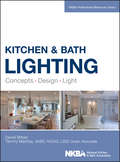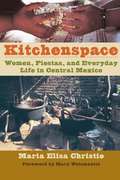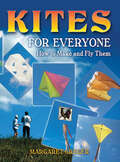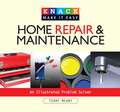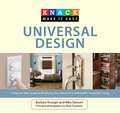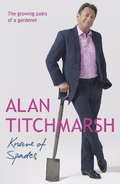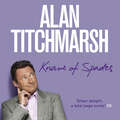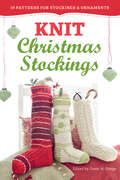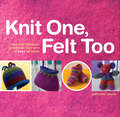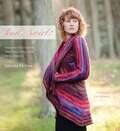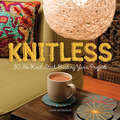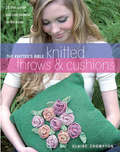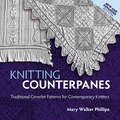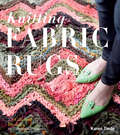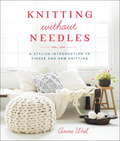- Table View
- List View
Kitchen Collectibles: An Identification Guide
by Kenneth L. CopeKitchen gadgets, tools, and appliances, like those found in your grandmother's kitchen, have become major collectibles, bringing increasingly higher prices. Yet, how can you put a value on an item that you can't identify? Here is the first book to concentrate on the identification of kitchen collectibles dating from 1830 to 1930. With over 600 manufacturers listed and described (as to location, date of operation, patents, and items made) and nearly 2,000 illustrations taken from original catalogs and advertisements, this book allows you to clearly identify your collectible. The offerings of such makers as Andrews Wire and Iron Works, Arcade Mfg., Dover Stamping, Enterprise Mfg., Erie Specialty, Kieckhefer Bros., Landers, Frary & Clark, Silver & Co., Wagner Mfg., and Watertown Cutlery (among many, many others ) are presented with a visual clairty that makes comparisons with your collectibles much easier and more accurate. To make identification easier still, the book contains an exclusive listing of the trade names associated with each manufacturer and another alphabetical listing of manufacturers with their associated patent dates. This permits the cross-reference, and thus identification, of collectibles even when they are not marked with a manufacturer's name but just a trade name or patent date. Mr. Cope also helps the reader identify non-American pieces by providing a separate list of abbreviations found on such items, together with their country and an English translation of their meanings. Finally, the book is fully indexed so that all kitchen items of any type can be located and viewed. This is information that cannot be found anywhere else and is absolutely invaluable to the collector, dealer, researcher, or anyone else who is simply interested in what grandmother used in her kitchen.
Kitchen Planning
by NkbaThe leading resource for student and professional kitchen designers-completely revised and updatedKitchen Planning is an essential reference for any designer working in the kitchen field, containing everything a professional needs to know to design kitchens that are convenient, functional, and efficient, and that meet the needs of today's lifestyles. Based on the National Kitchen and Bath Association's Kitchen and Bathroom Planning Guidelines and the related Access Standards, this book presents the best practices developed by the Association's committee of professionals through extensive research.This Second Edition has been completely revised and redesigned throughout, with new full-color photographs and illustrations and a special emphasis on client needs, research, and references to industry information. Features include:New and expanded information on universal design and sustainable designThe 2012 edition of the NKBA Planning Guidelines with Access Standards and up-to-date applications of the 2012 International Residential Code®New information about storage, cabinet construction, and specifying cabinetsMetric measurement equivalents included throughoutA companion website with forms and teaching resources for instructors
Kitchen Remodeling For Dummies
by Donald R. PrestlyReal estate, building, and remodeling surveys reveal that the one project likely to give you a 100 percent return on the dollars invested is a kitchen remodel. And whether the project is as involved as gutting the room back to the wall studs or as simple as applying a fresh coat of paint, each project is an investment in your home's value and, ultimately, in your enjoyment of using the space. Remodeling a kitchen is a big job, but it's not so big that anyone - with the right guidance and understanding - couldn't feel comfortable tackling at least some parts of the job. Kitchen Remodeling For Dummies is the reference tool to use if you Want to use the kitchen more efficiently Want to replace outdated, energy-gobbling appliances and gadgets Have attempted at least one or two home repair projects Are comfortable using both power and hand tools and probably own a few of each Want to know how a project should be done and then hire someone to do it. The kitchen in today's home has become a focal point for the family, as well as for entertaining. For those reasons, you want the room to be as functional as possible, without breaking your bankbook. With Kitchen Remodeling For Dummies in hand, you'll get the lowdown on the following topics and more: The kitchen remodeling process (knowing this makes you a smarter consumer) Critical design issues Working with the pros: architect, designer, contractor Establishing a budget and sticking with it Evaluating your plumbing, electrical, and ventilation systems Selecting and installing cabinets and countertops Choosing sinks, faucets, and appliances Working on walls, windows, and floors Hot trends and easy upgrades This handy guide shows you how to take your kitchen (no matter what shape it's in now) and remodel it so that it not only fits your wants and needs but also becomes a room you can be proud to use and show off.
Kitchen Things: An Album of Vintage Utensils and Farm-Kitchen Recipes
by Richard SnodgrassMany home cooks--and professionals, as well--swear by the tried-and-true implements they've used for years: the Foley Food Mill that works like a charm every time; the manually operated juicer that's a tradition of family breakfasts; the cast iron skillet that's been handed down through the generations. For serious cooks, there's nothing like a familiar implement, a thing that works exactly as you expect it to.Similarly, most people usually have a library of favorite recipes on which they rely: some passed along from relatives and friends, others from mentors and teachers. These are the recipes cooks return to time and time again, in part because they evoke memories of the people who have enjoyed them and prepared them in the past.Kitchen Things, by master photographer and respected novelist Richard Snodgrass, celebrates these well-loved objects and recipes and showcases them in an unexpected way--a way that touches upon the science of food, the physics of cooking, the sensory pleasures of eating, and indeed the very nature of life itself.In his reflections, the author is aided by his patient, persistent, and very perceptive wife, Marty, and her mother, from whose Western Pennsylvania farmhouse kitchens the objects and recipes were sourced. The gentle, often humorous repartee between the author and these wise and knowing women forms a running narrative throughout the book.
Kitchen Witch: Natural Remedies and Crafts for Home, Health, and Beauty
by Katie Haegele Nadine SchneiderCast a spell to turn your kitchen into a healthy haven. Learn about traditional healing methods, gain practical DIY skills, and extricate yourself from reliance on the toxic consumer products that we have come to take for granted. Recipes and tips cover all aspects of a natural lifestyle, from home and garden to body and mind. Simple instructions and a thorough list of tools and ingredients provides you with everything you need to get started, while the annotated bibliography steers curious readers to even more information. Simple, traditional living can connect us with our ancestors, our children, and ourselves, especially during this time of political turmoil and environmental crisis.
Kitchen and Bath Business and Project Management (Second Edition)
by National Kitchen Bath AssociationKitchen & Bath Business Project Management, Second Edition is a comprehensive guide to professional practice for the kitchen and bath professional. This one-stop reference is based on the real-world experiences of kitchen and bath experts to ensure success in business and professional life. Kitchen & Bath Business Project Management, Second Edition is illustrated in full color throughout with improved graphic design so that visual learners can easily absorb both technical and professional practice information. This book also includes access to a companion website with easily customizable forms for increased efficiency, and an Instructor's Manual.
Kitchen and Bath Design
by Mary Fisher KnottThe all-in-one reference to designing stunning and functional kitchens and baths Designing for today's kitchens and baths requires technical savvy, a keen eye for aesthetics, and perhaps most important of all, the ability to coordinate efforts across many disciplines. Kitchen and Bath Design simplifies these complex decision-making processes with a comprehensive strategy for achieving kitchen and bath designs that successfully integrate beauty and practicality-while meeting client expectations. Fundamental design basics are covered, along with a host of important issues that designers must consider when conceptualizing these specialized rooms, such as ergonomics, codes and safety requirements, proper lighting and ventilation, flooring, cabinetry, countertops, wall surfaces, and more. Some of the topics that appear in this book include: A detailed introduction to construction, plumbing, and electrical basics A systematic approach to incorporating "green," energy-conscious design An overview of crucial design elements, including pattern, texture, line, form or mass, color, space and light, and sound The latest building codes and manufacturers' guidelines Written by a leading expert in interior design, Kitchen and Bath Design uses three-dimensional drawings and corresponding photographs to deliver valuable information that is critical when it comes to planning, designing, specifying, estimating, building, pricing, or evaluating a kitchen or bathroom. Whether they're working on a new or existing space, professional designers can apply the lessons learned from this current andaccessible resource to masterfully take on all kitchen or bathroom projects-from the simplest to the most highly challenging.
Kitchen and Bath Design Principles
by Nkba Ellen Cheever Nancy WolfordThe industry standard, full-color guide to practical kitchen and bath designKitchen and Bath Design Principles is The National Kitchen and Bath Association's complete guide to uniting function and style in these important rooms. This full-color guide is heavily illustrated, with a revised layout and graphic design that presents information more clearly for visual learners. The updated second edition has been expanded to adhere more closely to the standards of interior design, including new information on unity, proportion, scale, and variety, plus a new glossary to clarify unfamiliar terms. Stylistic themes remain a major component, with emphasis on the architecture, furniture, styles, and fashions of each era, and all technical and aesthetic information is presented in clear, concise language. The companion website features a teacher's guide and image bank that facilitate use in the classroom, providing additional examples of design principles in action.The National Kitchen and Bath Association established the standard guidelines for safe and effective kitchen and bath design, and this book is the complete guide to incorporating code and aesthetics from the very beginning. Function is just as important as style in these rooms, so Kitchen and Bath Design Principles teaches readers to:Apply the elements and principles of design to real-life situationsDiscover how best to apply the tools of design in daily business practiceExplore the global and cultural influences reflected in popular stylistic themesTranslate the aesthetics of an era into a workable theme for a kitchen or bathTo best serve clients, designers must learn to meet all codes, regulations, and expectations with a balance of substance and style. Kitchen and Bath Design Principles is the industry standard reference, from the industry-leading provider of kitchen and bath design education.
Kitchen and Bath Lighting
by Tammy Mackay Dan BlitzerThe industry standard illustrated guide from the National Kitchen and Bath Association Co-published by the National Kitchen and Bath Association (NKBA), Kitchen and Bath Lighting is the go-to resource for designing, planning, and installing light in residential kitchen and bath projects. Full color illustrations throughout the book make Kitchen and Bath Lighting a visually absorbing experience. This beautiful volume begins with the basics of light, color, and vision, progressing from there through every stage of the residential lighting design process. With special attention to sustainability and lighting for older eyes, this book contains the information you need to know about the latest trends impacting the lighting industry. Because the NKBA established the standard kitchen and bath guidelines for both new construction and remodels, Kitchen and Bath Lighting is aligned with the practices that are in high demand. This book is also an excellent choice for anyone hoping to obtain credentials as a Certified Kitchen Designer or Certified Bath Designer. Comprehensive coverage of the kitchen and bath lighting process, from the fundamentals of color to design documentation to construction Illustrated guidelines for using lighting tools like sources, luminaries, and controls in design development Glossary and end-of-chapter exercises for quickly learning and referencing key terminology and lighting techniques Companion website offering resources for instructors This new addition to the NKBA's Professional Resource Library is an essential reference for kitchen and bath designers, lighting designers, and interior designers, as well as contractors, retrofitters, specifiers, and anyone else involved in lighting kitchens and bathrooms. Kitchen and Bath Lighting will give you the visual understanding of lighting that can lead directly to client satisfaction.
Kitchenspace
by Maria Elisa ChristieThroughout the world, the kitchen is the heart of family and community life. Yet, while everyone has a story to tell about their grandmother's kitchen, the myriad activities that go on in this usually female world are often devalued, and little scholarly attention has been paid to this crucial space in which family, gender, and community relations are forged and maintained. To give the kitchen the prominence and respect it merits, Maria Elisa Christie here offers a pioneering ethnography of kitchenspace in three central Mexican communities, Xochimilco, Ocotepec, and Tetecala. Christie coined the term "kitchenspace" to encompass both the inside kitchen area in which everyday meals for the family are made and the larger outside cooking area in which elaborate meals for community fiestas are prepared by many women working together. She explores how both kinds of meal preparation create bonds among family and community members. In particular, she shows how women's work in preparing food for fiestas gives women status in their communities and creates social networks of reciprocal obligation. In a culture rigidly stratified by gender, Christie concludes, kitchenspace gives women a source of power and a place in which to transmit the traditions and beliefs of older generations through quasi-sacramental food rites.
Kites for Everyone: How to Make and Fly Them
by Margaret Greger"The most influential kitemaker you never heard of." -- American Kite. This thorough guide by an expert kitemaker includes easy-to-follow, illustrated instructions for creating and flying more than fifty kites. An easy and comprehensive introduction for anyone interested in these amazing flyers, the book opens with the history and science of kites, followed by a section on kite construction and flying. Organized according to kite types, Greger's book includes chapters on everything from simple bag kites to Vietnamese, Snake, Dutch, Dragon, Bullet, Delta, and Flowform flyers. She even tells how to make windsocks and toy parachutes!The book is a great aid for classroom teachers, camp counselors, and parents, offering practical suggestions on everything from setting up a workspace and observing safety rules to launching the kites and bringing them in. "Kites for Everyone is like having a veteran kite maker in the classroom," says Science and Children.
Knack Home Repair & Maintenance: An Illustrated Problem Solver (Knack: Make It Easy)
by Terry MeanyWhat you can fix, what you can't, and what to do until help arrives
Knack Universal Design: A Step-by-Step Guide to Modifying Your Home for Comfortable, Accessible Living (Knack: Make It Easy)
by Barbara Krueger Nika StewartFrom the basics to insider practical tips on the latest trends and products, readers will learn what it takes to create a home that makes life easier.
Knave of Spades: Growing Pains of a Gardener
by Alan TitchmarshWhen Alan left school at fifteen little was expected of him. An ‘O’ level in art is not the most obvious passport to success, but in the ancient greenhouses of the local nursery Mrs T’s little lad found his spiritual home, learning his trade and the strange ways of human nature.But the comfort and familiarity of his home in the Yorkshire Dales would soon be left behind as he journeyed south to college and then to Kew Gardens where he encountered rare plants collected by Captain Cook and a varied assortment of eccentrics in the world’s most famous garden.Spells as a teacher and editor followed, until fate took a hand when he landed a job on BBC’s Nationwide as their gardening presenter. His childhood dream of inheriting the mantle of gardening god Percy Thrower was beginning to come true...From the first faltering steps in radio and television, to a career in broadcasting and writing, Knave of Spades is a wonderfully warm and self-deprecatingly honest memoir. Alan Titchmarsh shows us just why he has become not only our favourite gardener, but a popular writer and broadcaster too.
Knave of Spades: Growing Pains of a Gardener
by Alan TitchmarshWhen Alan left school at fifteen little was expected of him. An 'O' level in art is not the most obvious passport to success, but in the ancient greenhouses of the local nursery Mrs T's little lad found his spiritual home, learning his trade and the strange ways of human nature. But the comfort and familiarity of his home in the Yorkshire Dales would soon be left behind as he journeyed south to college and then to Kew Gardens where he encountered rare plants collected by Captain Cook and a varied assortment of eccentrics in the world's most famous garden. Spells as a teacher and editor followed, until fate took a hand when he landed a job on BBC's Nationwide as their gardening presenter. His childhood dream of inheriting the mantle of gardening god Percy Thrower was beginning to come true... From the first faltering steps in radio and television, to a career in broadcasting and writing, Knave of Spades is a wonderfully warm and self-deprecatingly honest memoir. Alan Titchmarsh shows us just why he has become not only our favourite gardener, but a popular writer and broadcaster too.(P)2010 Oakhill Publishing
Knifty Knitter 2
by Provo CraftThis short guide offers easy to follow instructions for learning how to knit using the "Knifty Knitter" loom set. Instructions include patterns, stitches and suggestions for improvement. The instructions work well on any round loom, and this type of knitting is reminiscent of crochet. Bookshare also offers other pattern books for round loom projects. As a visually impaired person, it is suggested to use your fingers and not the loom tool to lift loops over the peg.
Knit Christmas Stockings, 2nd Edition: 19 Patterns for Stockings & Ornaments
by Gwen W. SteegeMake this holiday one your family will remember forever! With these 19 simple and fun patterns, even first-time knitters can create beautiful Christmas stockings for everyone on Santa’s list. Gwen W. Steege offers innovative ideas for crafting unique stockings full of personality, regardless of whether you’re looking for wacky or whimsical, classically beautiful or daintily darling. Transform smaller skeins and project leftovers into ministockings for pets or tree ornaments. Clear some room on the mantle and knit yourself a merry little Christmas.PLEASE NOTE: The patterns and instructions in this ebook rely on color illustrations and color sequences, and they will not fully render on black-and-white reading devices.
Knit One, Felt Too: Discover the Magic of Knitted Felt with 25 Easy Patterns
by Kathleen TaylorEasy enough for beginners and exciting enough to inspire experts, felted knitting offers endless possibilities for creative crafting. The method is simple and magical — knit the project large and loose, wash it in hot water, and see it transformed into a soft and cozy garment or accessory. Kathleen Taylor encourages you to explore the possibilities of felted knitting with 25 spectacular projects that include mittens, slippers, hats, bags, stuffed animals, and more. Embellish your life with unique and stylishly comfortable creations.
Knit, Swirl!
by Sandra McIverWithin the lavishly photographed pages of knit, Swirl!, designer Sandra McIver presents 18 designs that flatter all figures, each based on the innovative one piece, one seam circular construction she calls a “Swirl”. Using simple knitting techniques, she creates elegant sweater jackets in four dramatic silhouettes and three flexible sizes.
Knitless: 50 No-knit, Stash-busting Yarn Projects
by Laura McfaddenAre you a knitter, crocheter, crafter, or none of the above? This clever book gives yarn lovers--both knitters and non-knitters alike--50 fun ways to use their stashes without taking out their knitting needles. The projects are easy and simple, but with a modern aesthetic that manages to be both sophisticated and inviting. Get your hot glue gun fired up, adhere some pompoms to an old office chair, and make the most ho-hum seat in your house into a cozy piece of pop art furniture. Or treat your neck to a stylish infinity scarf. All you need is some bulky yarn and the ability to braid. This book will strike a chord with DIYers who love yarn but don’t always want to take the time and effort to knit something from it. Projects also include a Sputnik lamp shade, a welcome mat, friendship bracelets, and even a rehabbed woven lawn chair. Put away your needles and crochet hooks and create fabulous projects, from accessories to home goods and more!
Knitted Throws & Cushions: 25 Chic, Stylish and Cosy Projects for the Home (The Knitter's Bible)
by Claire CromptonThe established designer and bestselling author combines fabulous colors and textures with twenty-five stylish patterns that create striking home accessories. The Knitter&’s Bible: Knitted Throws & Cushions features an inspiring collection of knitted projects to brighten up the home, from luxury afghans and bedspreads to functional cushions and seating. The styles vary from basic beginner projects such as cushions and chunky throws to more advanced bedspreads and textured wall hangings. Inside, you&’ll: · Discover the design secrets behind each project and choose color schemes to incorporate the projects into your own interior style · Experiment with eye-catching embellishments, sumptuous yarns and easy-to-follow techniques to simply beautify your home Knitting for your home is a lovely way to add a touch of handmade beauty to your interiors, add drama for a party, and dress up your furniture in colors that match the seasons.
Knitting Counterpanes: Traditional Coverlet Patterns For Contemporary Knitters (Dover Knitting, Crochet, Tatting, Lace)
by Meg Swansen Mary Walker PhillipsMary Walker Phillips nearly single-handedly brought nineteenth-century counterpanes, or bedspreads, to the attention of modern knitters. This book is the product of her international searches of museums, private collections, and magazines, a quest that yielded a choice selection of 46 counterpane patterns as well as 32 lace edgings and borders. Expanded with dozens of brand-new charts, this revised edition of Phillips' influential work makes the patterns even more accessible to knitters of all levels."This is a terrific book," noted Knitter's Magazine, adding that "the directions, photos, and general production are crisp and clean, just like its subject." The patterns are grouped into chapters by design effect. Within each chapter, they proceed logically from simplest to most complex. Each is accompanied by a photo of its component elements, which the author knitted especially for this book. The patterns include assembly diagrams where needed as well as possible variations. Beginners, experts, and everyone in between will find this volume a splendid resource of versatile patterns.
Knitting Fabric Rugs: 28 Colorful Designs for Crafters of Every Level
by Karen TiedeWith just a few tools and fabric, Karen Tiede gives you directions for making 28 different rugs with designs that use age-old motifs, including stripes and spirals; traditional quilt patterns, such as tessellations and log cabin designs; and freeform inventions. She shows how to create a wide range of color modulations, as well as different shapes, from rectangles to circles. The results are beautiful, one-of-a-kind floor coverings and wall hangings that are perfect for your space and taste.
Knitting Without Needles
by Anne WeilWho knew you could actually knit without needles? Put down those complicated knitting projects that take forever to finish. Knitting Without Needles brings cool home, gifts, and clothing accessories--cowls, totes, rugs, poufs, scarves, and more--within arm's reach. An all-in-one resource for a new kind of craft, this book shows you how to loop yarn with your fingers or your forearms with thirty patterns that are simple to follow and produce stylish results. Best of all, many of them knit up fast--in less than an hour! Even if you've never picked up knitting needles, you can easily master the techniques to make fun knits with kids and for kids (a princess crown, baby booties) and even last-minute gifts (a statement necklace for your fashionista friend). With stunning photography, plenty of step-by-step photos, and a detailed resource section, Knitting Without Needles is your go-to for a new way to knit.From the Trade Paperback edition.
Knitting Without Needles: A Stylish Introduction to Finger and Arm Knitting
by Anne WeilWho knew you could actually knit without needles? Put down those complicated knitting projects that take forever to finish. Knitting Without Needles brings cool home, gifts, and clothing accessories--cowls, totes, rugs, poufs, scarves, and more--within arm's reach. An all-in-one resource for a new kind of craft, this book shows you how to loop yarn with your fingers or your forearms with thirty patterns that are simple to follow and produce stylish results. Best of all, many of them knit up fast--in less than an hour! Even if you've never picked up knitting needles, you can easily master the techniques to make fun knits with kids and for kids (a princess crown, baby booties) and even last-minute gifts (a statement necklace for your fashionista friend). With stunning photography, plenty of step-by-step photos, and a detailed resource section, Knitting Without Needles is your go-to for a new way to knit.From the Trade Paperback edition.
